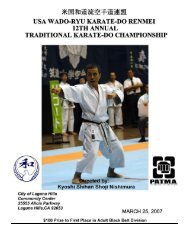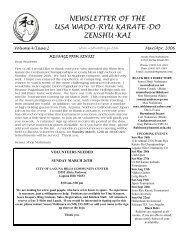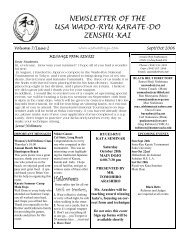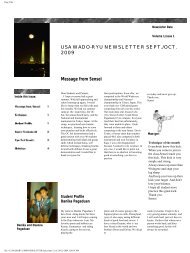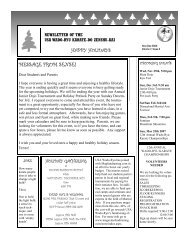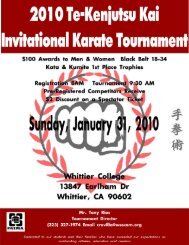You also want an ePaper? Increase the reach of your titles
YUMPU automatically turns print PDFs into web optimized ePapers that Google loves.
Page 2<br />
WORD OF THE MONTH: Coordination (Working together)<br />
EDISON COMMUNITY JUNIOR KARATE CLASS SMILING FOR THE CAMERA<br />
TOURNAMENT ETIQUETTE Rules and Regulations<br />
To begin, it is important to understand that our organization follows very strict guidelines and rules, which have been set<br />
in place to ensure safety during training and competition. These rules are sanctioned by the <strong>USA</strong> National <strong>Karate</strong>-do<br />
Federation (<strong>USA</strong>NKF) and are used in all the competitions that we attend.<br />
Division Category<br />
First and foremost it is important to know your correct division category for competition. These are the divisions according to<br />
<strong>USA</strong>NKF for Kobudo, Kata and Kumite.<br />
Beginner 0-1 year of training<br />
Novice 1-2 years of training<br />
Intermediate 2-3 years of training<br />
Advanced 3+ years of training<br />
Adults Over 18 years old<br />
Once a competitor has declared a particular category, then the competitor shall be deemed to be at that level of experience for all<br />
purposes. For example, an athlete may not compete in a ‘beginner’ Kata division and also enter an ‘advance’ Kumite division.<br />
Dress Code<br />
All contestants must wear a white unmarked <strong>Karate</strong> Gi without stripes or piping. Only the original manufacturers labels may be<br />
displayed on the gi (bottom right corner of the gi jacket and waist position on the trousers.) A contestant may wear a single patch<br />
or emblem identifying their respective <strong>Karate</strong> organization, school or system on the left breast pocket of the jacket.<br />
The maximum length of the gi jacket sleeves must be no longer than the bend of the wrist and no shorter than halfway down the<br />
forearm. Jacket sleeves may not be rolled up either on the outside or inside of the sleeve.<br />
Contestants must keep their hair clean and cut to a length that does not obstruct smooth bout conduct or present a safety hazard to<br />
competitors. Hachimaki (head bands) of any kind will not be allowed.<br />
In kumite, scrunchies, and metal hair clips (barrettes) are not allowed, and in kata, hair ribbons and other decorations are prohibited.<br />
Contestants must have short fingernails, and must not wear jewelry or other objects which might injure their opponents. Metallic<br />
teeth braces must be approved by the Referee and the Official <strong>Do</strong>ctor.<br />
Fist Pads, and Gum Shields are compulsory for all competitors, and Groin Protectors are compulsory for all male competitors.<br />
Woman may wear authorized chest protectors<br />
Soft shin pads are allowed as long as they do not cover the instep of the foot.<br />
Glasses are forbidden in all divisions<br />
For Adult, Junior and Senior beginner, novice and intermediate divisions, a competitor may elect to use an approved soft foam<br />
head protector<br />
All the Referees have to abide by these rules, and do so rigidly, so if you forget your mouthpiece, or you think that head<br />
band looks super cool, learn the code and think again, it may save you from that walk of shame…….





